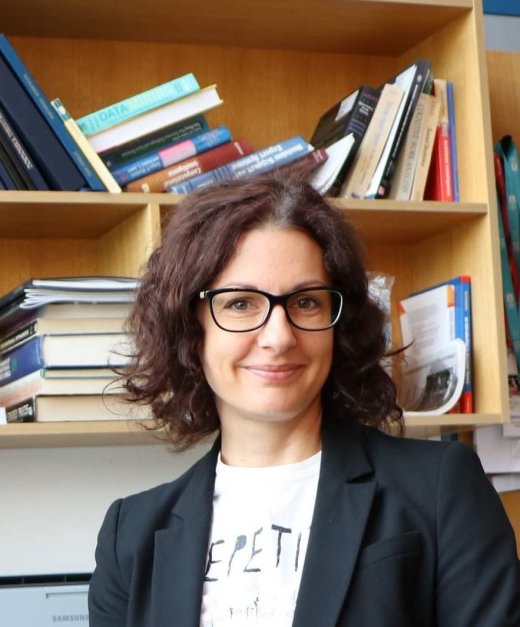5 Questions about Digital Sustainability to… Mirjana Kljajić Borštnar

Slovenia has become the first EU member state to establish a Ministry of Digital Transformation. We spoke to Mirjana Kljajić Borštnar – a full professor at the University of Maribor’s Faculty of Organisational Sciences in the Department of Information Systems, and also vice president of the Slovenian Society Informatika. Here, she explains more about the current challenges in her country, and outlines what kind of support is needed to help organisations and societies to improve their digital sustainability.
“It’s not enough to simply digitalise the processes; it’s about adding value in economic, social and environmental terms at the same time.”
How would you define the term ‘digital sustainability’, and what does it entail?
As academics, we have been thinking about the sustainable transition for many years now. Around a decade ago, the focus in information systems was on how ‘green’ information systems could be designed to consume less energy themselves and also to support business processes to reduce the overall need for resources. ‘Digital sustainability’ expresses a shift in that thinking, acknowledging the fact that the digital transformation is now about more than just technology alone. I often think of the quote by George Westerman from the MIT Sloan School of Management, who said “Successful digital transformation is like a caterpillar turning into a butterfly. It’s still the same organism, but it now has superpowers.” In other words, if you get digital transformation wrong, all you end up with is a really fast caterpillar that consumes a lot of resources but doesn’t offer any real benefit. Therefore, it’s not enough to simply digitalise the processes; it’s about adding value in economic, social and environmental terms at the same time, throughout the entire lifecycle of a product or service – from the design, through to the final phase of use.
I see it as a good sign that more people seem to be talking about the sustainable digital transition right now. This is helped, of course, by the fact that the EU is investing in this topic. Talking is good, but the challenge now is to put digital sustainability into action in a viable manner for all stakeholders. For this, you need to find long-term value in redefining the business models and you need a long-term vision of how things will work out.
What is the current state of play in the shift to digital sustainability in Slovenia?
In the Open Data Maturity Report, we rank among the ‘fast-trackers’, which is the second best cluster, for maturity in terms of open government data. But apart from that Slovenia has traditionally hovered around the middle of the EU’s Digital Economy and Society Index (DESI) ranking. We are keen to improve our performance across all criteria and become one of the higher-ranking countries. In fact, we want to go beyond just these benchmarking indicators and make digital sustainability improvements that add real value for businesses and society as a whole. For example, our healthcare system has some challenges, so we hope that by digitalising the nation’s healthcare services we can make the processes faster and better for everyone. We are also aware of the need to improve people’s competencies to use digital services. But everything starts with improving the infrastructure to make those services available for everybody.
To help us with this, since the start of this year the Republic of Slovenia has an official Ministry of Digital Transformation. This is actually the reincarnation of a similar ministry we used to have – the Ministry for Information Society – in the late 1990s but was later restructured and became part of another ministry. The intention is that the new ministry will enable us to achieve our goals easier and faster, and ensure that the digital transformation benefits everyone. One way will be through legislation. The Digital Slovenia 2030 strategy has now been adopted, and it serves as an umbrella strategy that connects all aspects of the digital transformation, with human and environment in the centre. There are also quite a few incentive projects to encourage the right infrastructure to be put in place. Besides these activities at the policymaking level, there are some smaller projects at the operational level supporting competencies across all age ranges – from senior citizens to young children.
Knowledge exchange is also an important part of driving our digital transformation. For example, the ministry was a key partner in the 30th DSI Conference ‘Slovenian Days of Informatics’ that took place in May this year. The conference originated from a very forward-thinking vision by the people at the Slovenian Society Informatika back in the mid-1970s, who realised that people can achieve more together than individually. Therefore, they decided to launch an annual national conference across all the domains – from technological faculties such as computer science, to information systems and economics – for stakeholders from public administration, industry and academia, including young students to involve the future generation. The theme of this year’s conference was ‘Co-creating a digital and sustainable (digi-tainable) Slovenia’. Not least thanks to the numerous national and international keynote speakers, itwas a great success in terms of showcasing the latest research and innovations and facilitating discussion of how the digital transformation can be put into practice.
For us as academics, it has been rewarding to see that our message is now being heard by the policymakers too. But we also realise that we still have a long way to go to get to where we want to be. In particular, I have worked a lot with small and medium-sized enterprises, and notice that many of these SMEs are really lagging behind in the digital transformation because, compared to bigger companies, they often lack the resources – financial, human, time and/or knowledge – to efficiently leverage the growing amount of data. We need to take care that all companies join us on the digital transformation wagon!
What can be done to help those companies to digitally transform in a sustainable manner?
As I always say, “We can buy tech, but we can’t buy the organisational culture”. And basically, if we view ‘society’ as just a very big organisation, this is a message for the policymakers: they need to lead by example to change the culture. That starts with providing safe and secure access to data, and also transparency in order to build the all-essential trust… because as INNOPAY’s own Mariane ter Veen rightly said during her presentation at the conference, we won’t succeed without trust. Legislation is one way to do this, but it’s important to put regulations in place that are clear and easy to understand. In Slovenia, the bureaucracy can be a struggle; we tend to make things more complicated than necessary. Another keynote speaker at our conference – Jack Hamande, Director General of Simplification and Digitalisation from Belgium – emphasised the role of simplification in the digital transformation. We definitely need to simplify things so that SMEs can comply with all the regulations and procedures rather than being ‘punished’ by them.
Besides this top-down approach, we also need to drive the transition from the bottom up by providing incentives for businesses and individuals. If we don’t provide incentives for SMEs, for example, they won’t be thinking “I want to be sustainable”; they will be thinking “I need to survive”. So the support for them must be more than just lip service – it must make it easier for their businesses to thrive.
And of course, the digital transformation affects the whole community, including employees in workplaces and citizens who use the digital services. Therefore, I am a firm believer in education. Subjects such as maths, computer science and information systems should receive much more focus in schools – and why not even kindergartens? – to take the mystery out of things like algorithms and artificial intelligence. Only then can digital tech be fully exploited to help us deal with today’s and tomorrow’s societal challenges such as sustainability and the environment.
How does your organisation help to put digital sustainability into practice?
Together with other domain experts, the Statistical Office of the Republic of Slovenia, the Chamber of Commerce and the Digital Innovation Hub Slovenia, my research group at the University of Maribor was involved in developing the Digital Maturity Assessment Model. This is aimed specifically at helping SMEs to evolve from a ‘data-immature’ to a ‘data-mature’ enterprise. We followed a design science research approach and the steps of a DEX methodology to formulate a multi-criteria model. This includes indicators of organisational capabilities based on the organisational culture, competences, management and decision-making style. It also includes technical capabilities based on the use of things like business software solutions, social media apps and advanced tech such as Industry 4.0, automation, robotics, AI and data analytics, and also the use and exchange of data both internally and externally, and so on.
The resulting model has already been used by around 1,500 SMEs in Slovenia. It forms a good basis for assessment because it takes into account each company’s individual circumstances. And it goes a step further than a benchmarking index to provide transparent feedback, including reasoning, so that each business knows why they got this result, what they can do to improve it, and what is the smartest way to get from where they are to where they want to be. The methodology is based on an open-source expert system shell, so in theory it can be used by anyone to make and shape their own tool. Slovenian companies are required to complete this assessment if they want to qualify for funding to support digitalisation, both during the application process and then one year and two years later. This makes a valuable contribution to knowledge building, enabling the government to monitor how efficiently the funding is being implemented and evaluate whether any fine-tuning is needed.
What would be your recommendation for other organisations in terms of becoming more digitally sustainable?
It’s not realistic to expect all SMEs and other organisations to transform both digitally and sustainably at the same time. It is a step-by-step process that starts with an assessment of where they are. They then need to think about where they want to go and create an action plan to bridge the gap between here and there. And as I mentioned earlier, it’s nice if the organisation has sufficient resources to achieve that. If not, support would come in handy, so it makes sense to find out what incentives are available to them.
One thing that really resonated with me during Mariane ter Veen’s speech at our conference was the importance of working together. Only then can we co-create innovative solutions and business models that are financially viable, but also take the environment and local community into consideration. It seems that ‘co-creation’ has been a buzzword for over a decade, but do we really know how to do it? It requires us to think about the added value in terms of the business ecosystem as a whole rather than just within a particular business model. This is an important difference, because it brings other stakeholders into the equation – such as policymakers, banks and even competitors who can find themselves working together with one another as ‘co-creators’ in certain situations. That's why trust is so important, so I hope that government, academia and industry will continue to work together to establish a fair and transparent infrastructure for data sharing as the basis for this.




